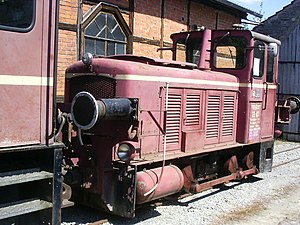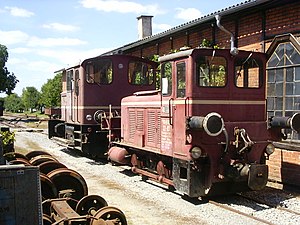Jung L 10 B
| Jung L 10 B | |
|---|---|
| Numbering: |
KOK No. 11 Jagsttalbahn 22-03 and two others |
| Number: | 3 |
| Manufacturer: | Young |
| Year of construction (s): | 1953-1954 |
| Axis formula : | B. |
| Gauge : | 750 mm |
| Length over buffers: | originally 5,021 mm after renovation 6,100 mm |
| Length: | 4,350 mm |
| Height: | 2,780 mm |
| Width: | originally 1,820 mm after renovation 2,100 mm |
| Total wheelbase: | 1,500 mm |
| Service mass: | originally 12,000 kg after conversion 13,800 kg |
| Friction mass: | originally 12,000 kg after conversion 13,800 kg |
| Wheel set mass : | originally 6,000 kg after modification 6,900 kg |
| Top speed: | 20 km / h |
| Installed capacity: | 77.3 kW (105 PS) |
| Driving wheel diameter: | Originally 700 mm after conversion 600 mm |
| Motor type: | MWM RHS 418 V |
| Motor type: | Four-cylinder four-stroke diesel engine |
| Power transmission: | hydraulic |
| Brake: | Originally foot or hand brake after conversion of indirect brake type Knorr |
Two -axle narrow - gauge locomotives from the Jung locomotive factory with a track width of 750 mm were designated as Jung L 10 B , three copies of which were manufactured from 1953 and used in shunting and light handover services. One locomotive has been preserved.
history
The name Jung L 10 B was derived from: L = narrow-gauge locomotive, 10 = approximately 1/10 of the engine power in HP and B = wheel arrangement.
The first locomotive was delivered to Farbwerke Hoechst in 1953 , and two more locomotives followed the next year.
technology
The locomotive has a front end for the machinery and a driver's cab behind it. The stems have mostly smooth surfaces, the corners are rounded.
The machine system was designed for Farbwerke Hoechst in an explosion-proof design. The water-cooled four-cylinder four-stroke diesel engine RHS 418 V from the Mannheim engine works was started with compressed air, which was generated by an air compressor with a roller chain . These safety devices were removed before use on the Osterode – Kreiensen railway line . The engine gave his force to a fluid transmission from Voith off, followed by a reversing gear of Jung. This gave the power to an off-axis group Blindwelle from. The drive wheels mounted in the outer frame were driven via drive rods and coupling rods with the help of crank pins.
commitment
Farbwerke Hoechst
The color works started using the locomotives from 1953. The machines were particularly on the move with freight carts. The locomotive, which was later used on the Jagst Valley Railway, was in service until 1958. There is a photo that shows the locomotive at the end of duty in 1958 with a bouquet of flowers and a ribbon on which the words stand for loyal service .
Osterode – Kreiensen circuit
In 1962 the Kreisbahn Osterode acquired two of these locomotives, whereby the second locomotive without a motor was intended from the outset as a spare parts donor. Originally the locomotive had the bracket coupling common on narrow-gauge railroads, but before it was used on the Osterode – Kreiensen circuit , it was exchanged for a central buffer coupling common on this railroad . In addition, the locomotive was given strong buffer beams with pulling and buffing devices so that jacked up standard-gauge freight wagons could also be coupled. Before it was used on the Jagst Valley Railway, this facility had to be adapted to the standard of the railway company. Originally only equipped with a footbrake and handbrake, with the conversion the locomotive received an indirect brake and a triple headlights .
After the locomotive was sold to the Kreisbahn, the changes were initially made at Henschel in Kassel. The locomotive was given the designation 11 .
It was used primarily in the shunting service and at the Osterode train station . After ceasing to operate in 1967, it was acquired by Südwestdeutsche Eisenbahn-Gesellschaft mbH in 1970 .
Jagst Valley Railway 22-03
For use on the Jagsttalbahn , the locomotive first received a general inspection in Möckmühl , during which the pulling and buffing equipment was adapted to the Jagsttalbahn standard and the paintwork was renewed. The locomotive was given the designation 22-03 and served primarily as a reserve for the company and, due to its low speed and the small driver's cab, in shunting service. She got the nickname Stubble Hopper .
After the Jagst Valley Railway was discontinued in 1988, the locomotive came to the Jagst Valley Railway Friends and is still there.
literature
- Author collective: The vehicles of the Jagsttalbahn , Friends of the Jagsttalbahn, Dörzbach 1984, ISBN 3-924660-00-X , pages 67-70
- Stefan Lauscher / Gerhard Moll: Jung-Lokomotiven , EK-Verlag, Freiburg 2014, ISBN 978-3-88255-798-5 , page 306
Web links
- Website about the Jung L 10 B on the Jagsttalbahn website
- Website about the Jung L 10 B as a model
- Website about the Osterode-Kreiensen circuit with a mention of the Jung L 10 B
Individual evidence
- ^ Stefan Lauscher / Gerhard Moll: Jung-Lokomotiven , EK-Verlag, Freiburg 2014, ISBN 978-3-88255-798-5 , page 306
- ^ A b c d e Author collective: The vehicles of the Jagsttalbahn , Friends of the Jagsttalbahn, Dörzbach 1984, ISBN 3-924660-00-X , pages 67-70

